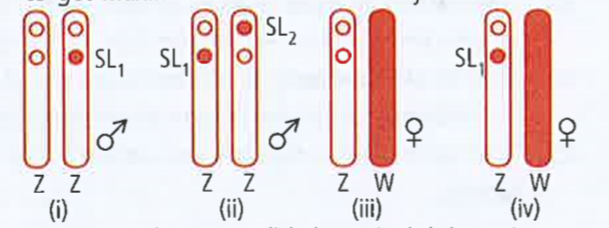Males of silkworm Bombyx more are known to produce more silk per unit quantity of leaf consumed. Hence, they are preferably bred in sericulture industry. Which of the following genotypes should be crossed in order to get maximum fraction of male insects ?

Note : SL1 and SL2 are sex-linked recessive lethal mutations
A
(i) and (iv)
B
(i) and (iii)
C
(ii) and (iii)
D
(ii) and (iv)
Video Solution
Text Solution
The correct Answer is:B
In silkworm, ZZ individuals are males while ZW individuals are females SL1 and SL2 are sex-linked recessive lethal mutations which, if present in homozygous condition, can be lethal and may lead to death of the individual. In order to get maximum fraction of male insects (i) and (ii) should be crossed because there will be 50 % of the male progeny that will be completely normal and free of lethal allele.
|
Updated on:21/07/2023
Topper's Solved these Questions
Knowledge Check
- Question 1 - Select One
1. Obesity-linked "adult on-set” diabetes mellitus is for the first time being reported in children and adolescents in the UK and many other countries. A 1986 landmark study of obesity and television viewing found a clear association between the number of hours of television a child watched and the risk of that child becoming obese or over-weight.
2. In 12 to 17-year-olds, the prevalence of obesity increases by two per cent for every hour of weekly television time. A more recent study found that, while eight per cent of children watching one hour or less of television a day were obese, 18 per cent of children watching four or more hours were obese.
3. The more children watch television, the more they eat. (By comparison, even reading is a workout, at least in studies that have been done with obese children, perhaps because it engages their minds a bit more emphatically.) Television viewing prompts children to consume more food while they consume less energy, an ideal recipe for adiposity.
4. When children dictate family food choices, as is increasingly the case in the US, entire house holds are immersed in a miasma of one-dimensional sweet taste that reinforces juvenile preferences. Marketing of soft, sweet and salty foods is good business, and children are the most vulnerable targets.
5. Childhood obesity rates are highest in countries where advertising on children's television programmes is least regulated - in Australia, the US and England. Sweden and Norway maintain a virtual ban on advertising to children, and have consistently low levels of childhood obesity. Ireland, Belgium, Italy and Denmark pose restrictions on children's advertising and are pressing the other states of the European Union to do the same.
6. The US and other countries can afford to do no less. Public nutrition campaigns should go beyond vague recommendations to exercise and eat a balanced diet: the link between inactivity, junk food consumption and obesity should be made explicit. The food industry will lobby against these efforts, of course, claiming that they constitute “legislation of food choices”.
On the basis of your reading of the above passage answer the questions:
Which country is trying to put restrictions on children's advertising?AUSBEnglandCAustraliaDDenmark

